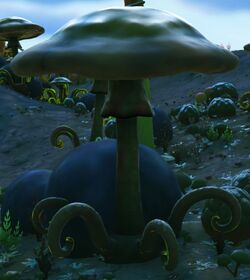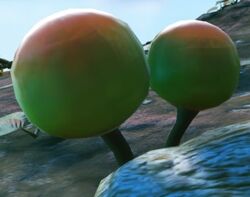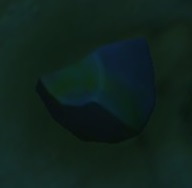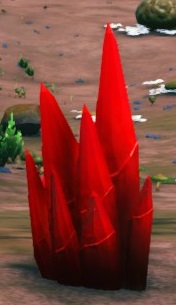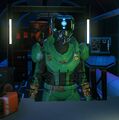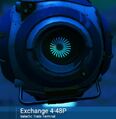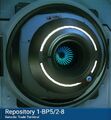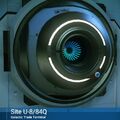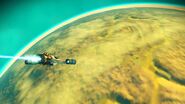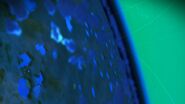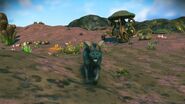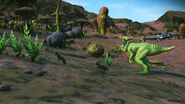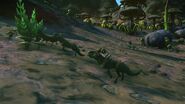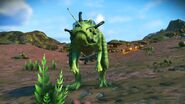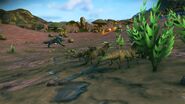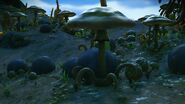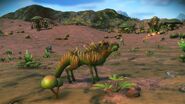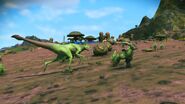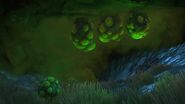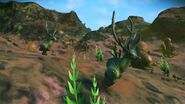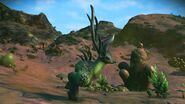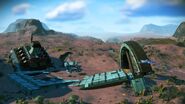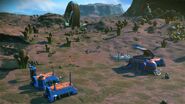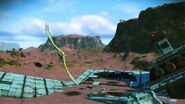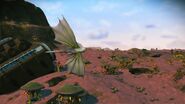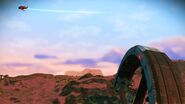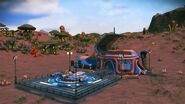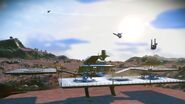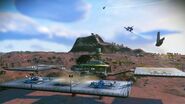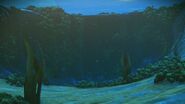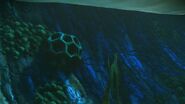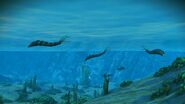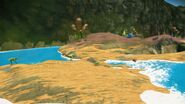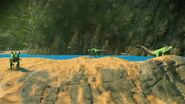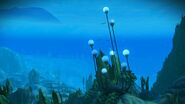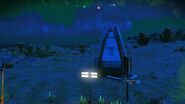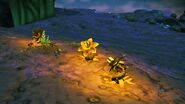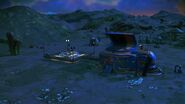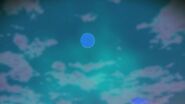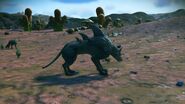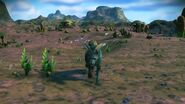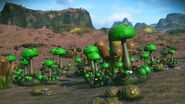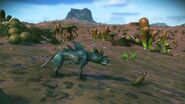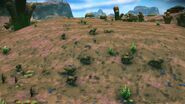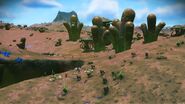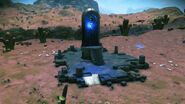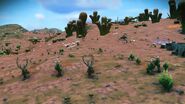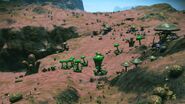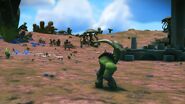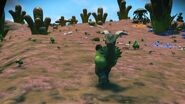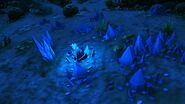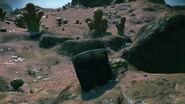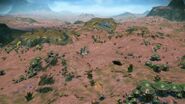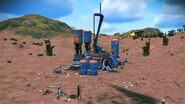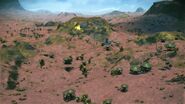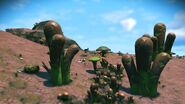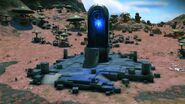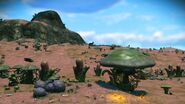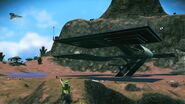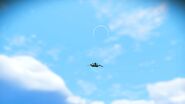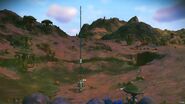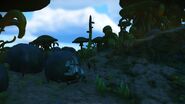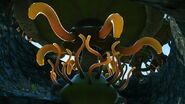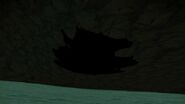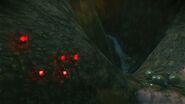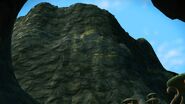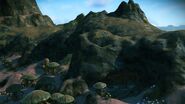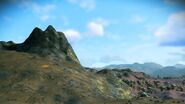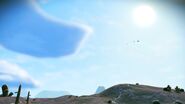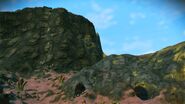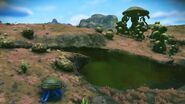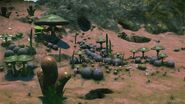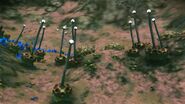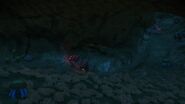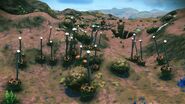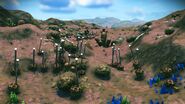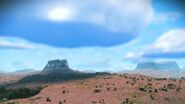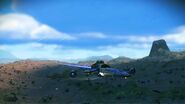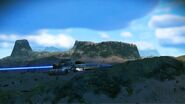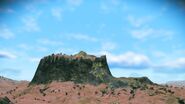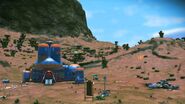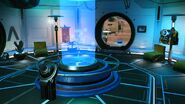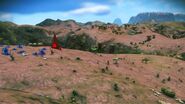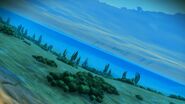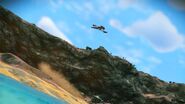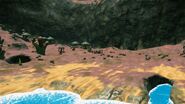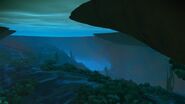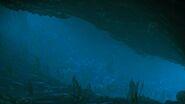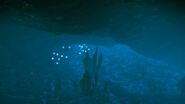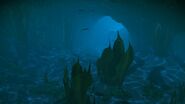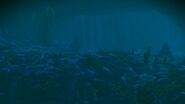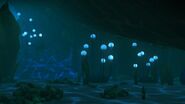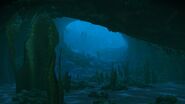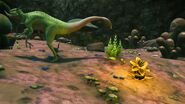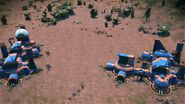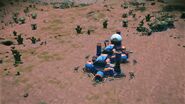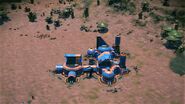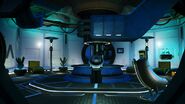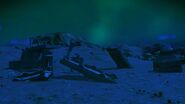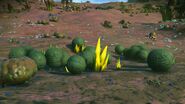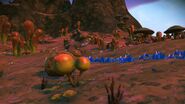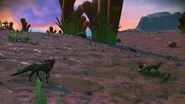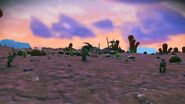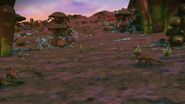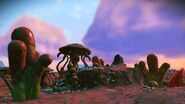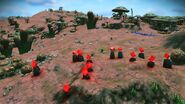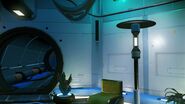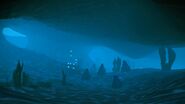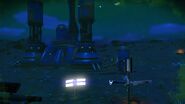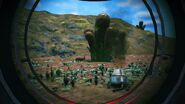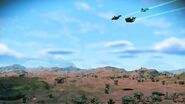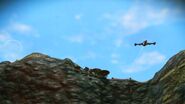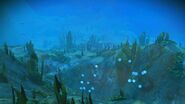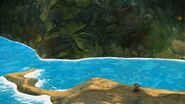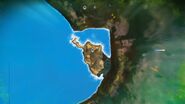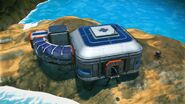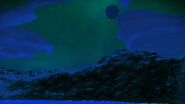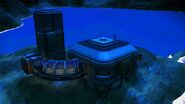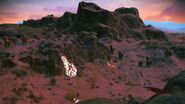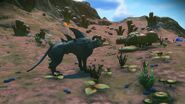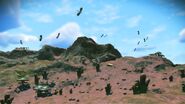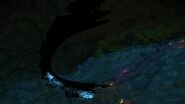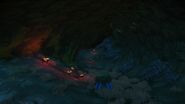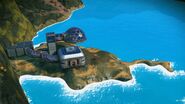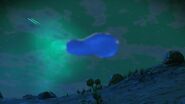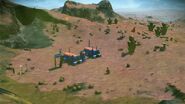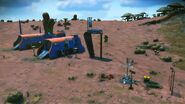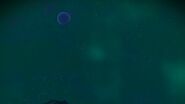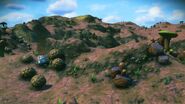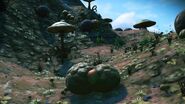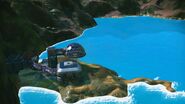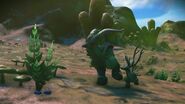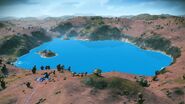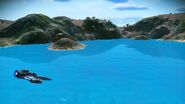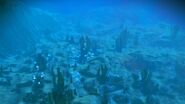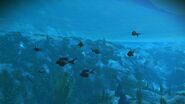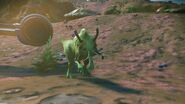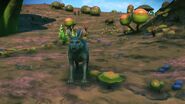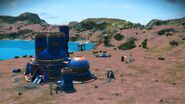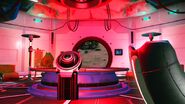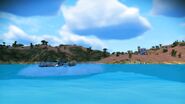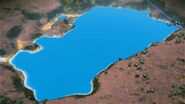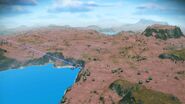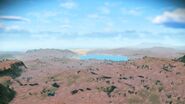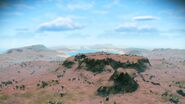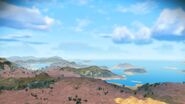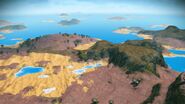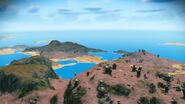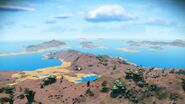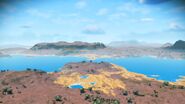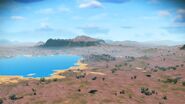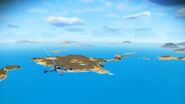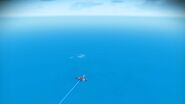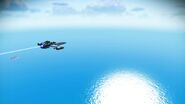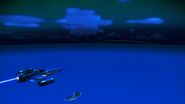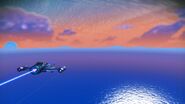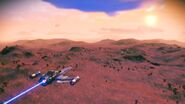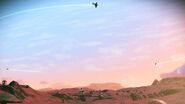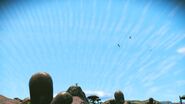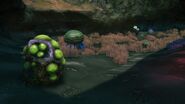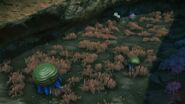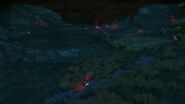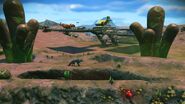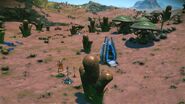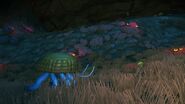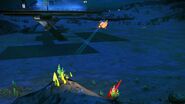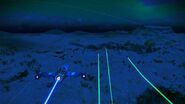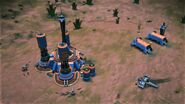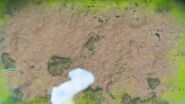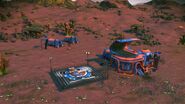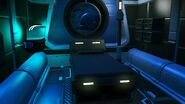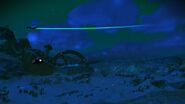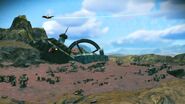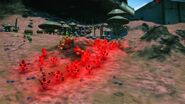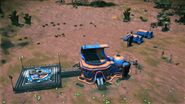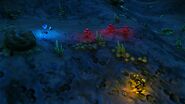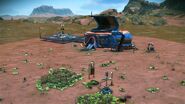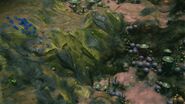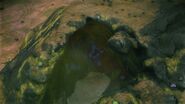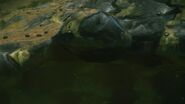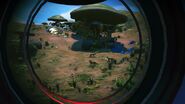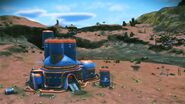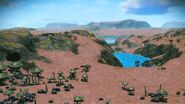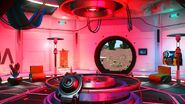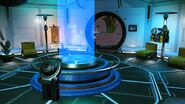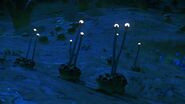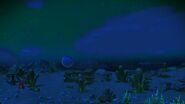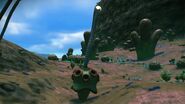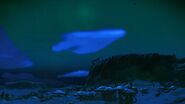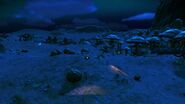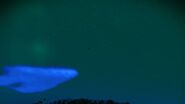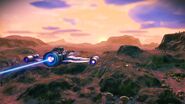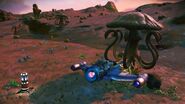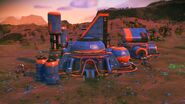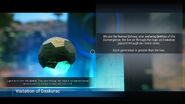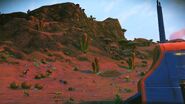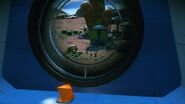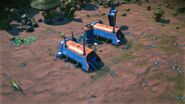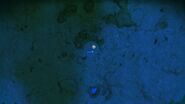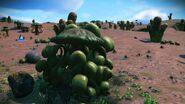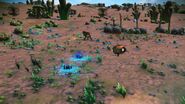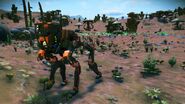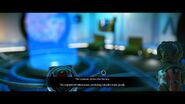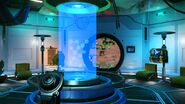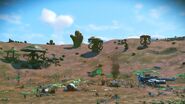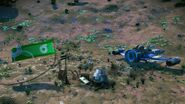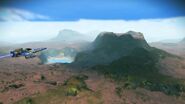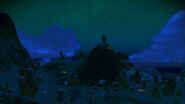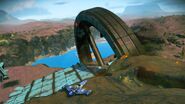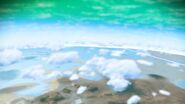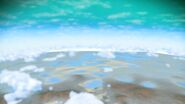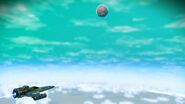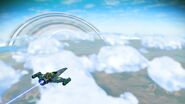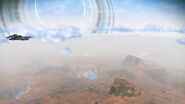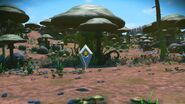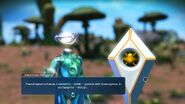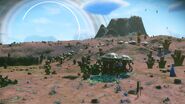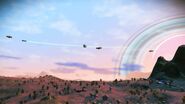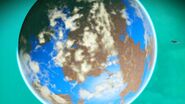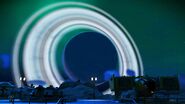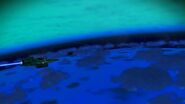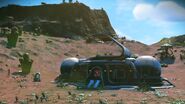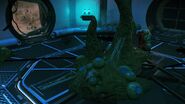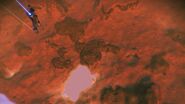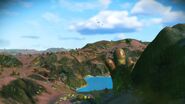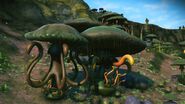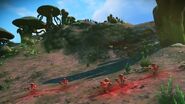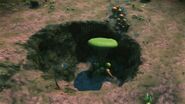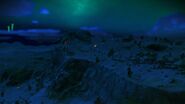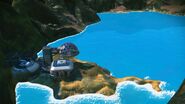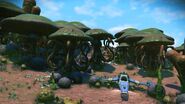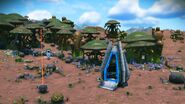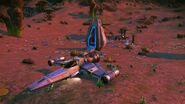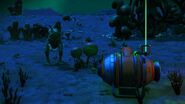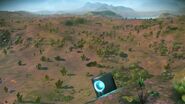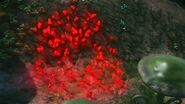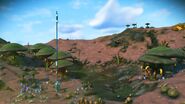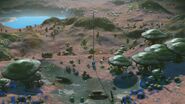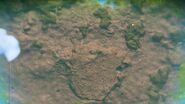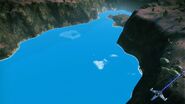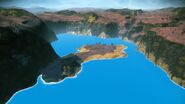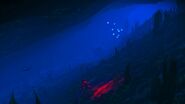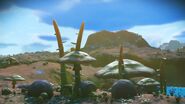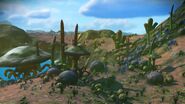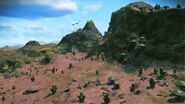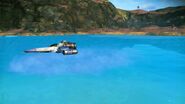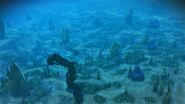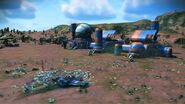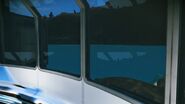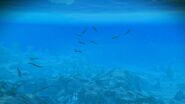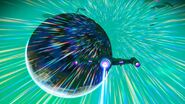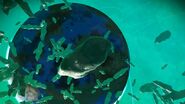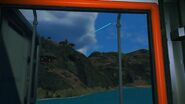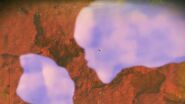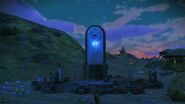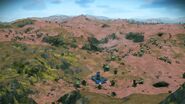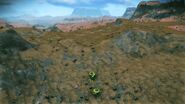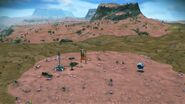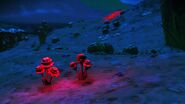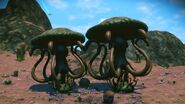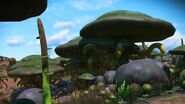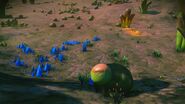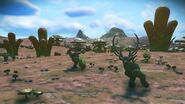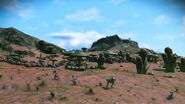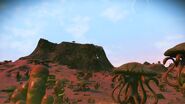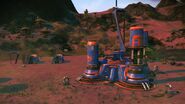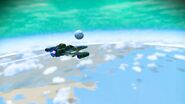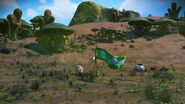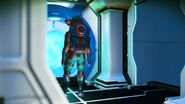| Kobastl Tau | |||
|---|---|---|---|

| |||
| General Information | |||
| Creator | Procedurally generated world | ||
| Alternate Names | Aberskyvinda-Unbu Aberskyvinda | ||
| Planet Type | Former: Torrid Planet Current: Rotting Planet | ||
| Universal Location | |||
| Universe | No Man's Sky Amalgam Universe | ||
| Galaxy | Euclid Galaxy | ||
| Sector | The Arm of Ospele | ||
| Cluster | Ospeleshv Fringe | ||
| System | Toxete System | ||
| Position | 1st | ||
| Orbital Characteristics | |||
| Satellites | 0 | ||
| Physical Characteristics | |||
| Atmosphere | |||
| Climate | Former: Sweltering Current: | ||
| Surface temperature | Former: 171.1°F (day) 138.6°F (night) Current: | ||
| Geography | |||
| Terra-Score | T2 | ||
| Terrain Hue | Tannish brown | ||
| Liquid Hue | Blue | ||
| Atmosphere Hue | Blue | ||
| Weather Class | Class 2 | ||
| Tectonics Class | Class 2 | ||
| Water Percentage | 10% | ||
| Primary Terrain | Wetlands, mesas, acidic lakes, venom caves | ||
| Sapients | Korvax, | ||
| Wildlife | Baiwe Stegobear, Cyclops Ballusk, Dalk, Eoherdus, Forest Stegobear, Goofy Ballusk, Gossipworm, Kobastl Darkdog, Kobastl Lakesponge, Kobastl Lakeworm, Mucktopus, Orcasaur, Orcbat, Pancake Snayl, Swampsponge | ||
| Vegetation | Caustic Drooptower, Common Puffball, Duckshroom, Flooette, Kobastl Cave Lichen, Kobastl Dragoneggs, Kobastl Tetherkelp, Mothhaven, Nailvine, Roguepea, Salem's Apology, Sousa, Whipshroom, Wolfhops | ||
| Political Information | |||
| Affiliation | Korvax Empire | ||
| Capital City | Ugaryang XV | ||
| Government | Korvax Empire | ||
| Population | 14 known individuals | ||
| Official Language(s) | Korvax, Loranchen | ||
| Strategic Information | |||
| Major Exports | Former: Solanium, Gold, Nickel, Heridium Current: Fungal Mould, Silver, Ammonia, Copper | ||
| Valuable To | Korvax | ||
Kobastl Tau (formerly known as Aberskyvinda-Unbu — /æ.bɜːr.skaɪˈvɪndʌ ʌnbuː/ — and occasionally shortened during this time by locals to "Aberskyvinda") is the first planet in the Toxete System, found within known Korvax space. Naturally a torrid world, it was resculpted via a Sculptor Device into a rotting world. It was known as the homeworld of the sapient Vindowls before their untimely demise during a massive extinction event caused by the resculpting.
The planet hosts Ronsal-Agjy Base, the current headquarters of the Loranche explorer Somarinoa at Anhuix Lake.
Summary[]
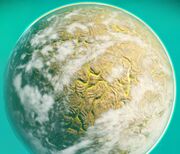
Aberskyvinda from a distance during the Fornaxian Period.
Kobastl Tau is a moonless planet in the Toxete System. Naturally it resided so close to the local star that it was constantly swelteringly hot, with a mean temperature of around 171.1°F during the day and 138.6°F during the night. A local sapient species had arose on the planet, known as the Vindowls. Vegetation was quite common, and a typical amount of fauna could be found here as well. Radon found in the ground gave the planet a rating of 0.5 rads and the atmosphere had trace amounts of toxins, leading to a rating of 2.9 tox.
However the planet was resculpted by the Korvax who purposely activated a long-abandoned Sculptor device, leading to a massive extinction event that nearly wiped all life off of the planet's surface.
Now a "terraformed" world, it currently has a mean temperature of around 103.2°F during the day and 67.3°F during the night. The acidic clouds and rain now give it a dangerous rating of 69.5 tox while trace amounts of radon and other radioactive elements in the soil give it an average rating of 1.9 rads. The waters are highly acidic and are nearly boiling hot, at a temperature in the day of 91°F and 79.1 toxicity.
The species that currently inhabit the planet mostly sprung up after the extinction event, and consist of some species that evolved quickly off some of the major species that happened to survive but for the most part are species that have been allowed to propagate now that there is nothing living holding them back. Other species were purposely exported from Amchasavy Owas by the Korvax, as that planet had formerly been acidic in nature and they believed this could help jump start a new life cycle for the planet.
History[]
Genetic Transference[]
Evidence has been recently uncovered that hints that the Gek First Spawn used enslaved Korvax to take life from nearby worlds and seed them across each other. Whether or not this had to do with the mass extinction events that had occurred or if it was a sheer display of dominance over planetary life is unknown. In the case of Thiaseuris, ancestral forms of several species were moved to and from here:
- Ilongoqungo: An ancestral species of Platerunner was imported, evolving into the Aberskyvinda Platerunner; Platinum Berries brought over evolved into Soul Tears.
- Thiaseuris-Ulgan Jeppj: A species of Skoff was brought over as a mad experiment, leading to the evolution of the Vindicated Baphomet.
- Zukabergo-Nama Gusuk: An ancestral species of Slateskull was imported, evolving into the Smug Slateskull; Snow Intestines evolved into Tacotestines.
Korvax Awakening[]
The Fornaxian-Senium Extinction Event[]
The Korvax's usage of the Sculptor device was a devastating blow to the inhabitants of Aberskyvinda-Unbu. Although life on the planet were extremophiles capable of surviving in oven-hot temperatures, they were not well adapted to deal with swampy conditions and constant acid rain. The earth beneath their feet cracked and buckled with the sudden cool down, creating numerous rifts and caverns throughout the planet's crust. Cursory calculations taken by Korvax researchers indicate that roughly 71.42% of vegetation and 90% of the wildlife went extinct during this event, including the local sapient species, the Vindowl. Of the surviving species, the Tacotestine would evolve into the Wolfhops, the Hotvine would evolve into a new species of Angervine, and the Vindicated Baphomet evolved into the Eoherdus, which ran unchecked for years and has become one of the two dominant herbivores on the planet.
Revitalizing a Lost World[]
With such a massive loss, the food web had completely crashed, leading to several guilt-pressured Korvax to initiate the Second Genetic Transference to usher in the Senium Period.
- Unknown Homeworld: Common Puffballs, a primary source the galaxy over for cultivated fungal mould, was imported from several regions and dropped from low orbit to populate the now-toxic world.
- Opishneli Ochi: The Warty Sponge was imported before the planet's atmosphere was stripped and placed into Genetic Arks, but some were later imported to Kobastl Tau and evolved into the Swampsponge.
- Dauenolaste: As the world was recently a toxic planet itself, a few species were imported to allow them to evolve into new forms. This includes the Insidious Axos which has since evolved into the Duckshroom and Whipshroom, and the Cotton Cantree which has since evolved into the Salem's Apology. The ancestor of the Churnhaix and Spittledome also originate from this planet. The Dauenolaste Palateworm was also transported over, which split into two cousin species, the Churnipede and the Gossipworm.
- Thiaseuris-Ulgan Jeppj: The Common Jettum was imported and has evolved into the Sousa.
- Zukabergo-Nama Gusuk: A former ice moon in a nearby planetary system was visited in order to import a species of honeycomb nemone that would evolve into the Kobastl Lakesponge.
Locations[]
|
|
|
Life[]
Flora[]
Fornaxian Period[]
| Name | Color | Discovered by | Brief description | |
|---|---|---|---|---|
| Brown trunk, deep red leaves | Somarinoa |  |
The primary tree species on the planet. Because of occasional high winds, their primary leaf is supported by a limb that wraps around its border, which the leaf attaches to at various points. The large holes in the leaf prevent it from being destroyed in the windstorms. Their roots extend deep into the planet, where they are swamped with subterranean springs, and this long root line lets them absorb levels of carbon and radon. They subsist on infrared radiation and produce a stinging fruit covered in small needles that keep most creatures away. Their cells are built to convert into youthful cells over time, causing the entire tree to return to a sapling state. This regeneration process makes them effectively immortal. They are a common food source for the local Vindicated Baphomets and Vindowls.
| |
| Drab yellow gourds | Somarinoa |  |
A species of gourd-like vegetation. They leech enzymes out of the local rocks, but since this breaks down their own stability over time, they have evolved omni-directional roots that extend in every possible direction, radiating outwards from the flora, making them very difficult to yank from the ground. So long as the roots remain, the Hellgourd can regenerate. However, patches of Hellgourd have been witnessed having a migratory pattern—after 10 or 11 cycles, an individual will finally die off, and a new stem will grow further out along the root structure from where the original was, roughly at the edge of the other's roots, creating a clone of the original. This keeps the soil from being too used up and is known to keep the gourds circling indefinitely around the planet.
| |
| Drab yellow | Somarinoa |  |
A species of angervine adapted to very hot temperatures. They have absorbed high levels of metal, giving them a high metal content consisting of carbon and radon. This is done over the matter of only several days and makes them searing to the touch and a tough nut to crack by organic weapons, thus making it difficult for prey items to escape its clutches. However, the high radon levels has caused its roots to become stunted and it can easily be ripped out of the ground. They normally feed via nitrogen fixation, but will kill organic life to supplement its diet whenever possible, as well.
| |
| Brown, woody stem; yellow leaves and stamen | Somarinoa |  |
A species of tall, woody flora that produce an odorless, yellow flower. Their root system is far-reaching, and individuals for miles around may extend off the same parent plant. Their roots are also carnivorous, and seek out sources of carbon dioxide that indicate possible dens for smaller subterranean creatures or decomposing matter, both of which they will extract nutrients from.
| |
| Various shades of blue | Somarinoa |  |
||
| Red stalk, fleshy seed pods | Somarinoa |  |
||
| Brown trunk, greenish-yellow leaves | Somarinoa |  |
The second most common tree on the planet, often found in conjunction with Devil's Fan. They are extremely slow-growing, taking centuries to reach roughly 20ft tall. Their root structure is narrow but elongated, making it hard to blow over during windstorms. Their leaves are slightly sticky, enabling them to entrap small invertebrates that are then directly ingested through the membrane. They are covered in a fine "dust", made up of the upper layer of their bark, which will brush off if touched and is a known ocular irritant. Their trunk and limbs are porous and during windstorms the wind blowing through these holes produces a long, low howl known locally as "Pol's Voice".
|
Senium Period[]
| Name | Color | Discovered by | Brief description | |
|---|---|---|---|---|
| Unspecified | Somarinoa |  |
Caustic Drooptower is a very fast-growing, toxic fungal species. Feeding on the vast swathes of soil-inhabiting bacterioids that infest and are rapidly breaking down the soil itself allows the Caustic Drooptower to grow to full height in only a matter of several days. This speedy growth affects their root structure however and it appears irregular by nature, with individuals having very different patterns.
Locals and scientists studying the species advise to steer clear of it without proper protection. This is because it possesses highly caustic, milky-white sap that contains skin irritants such as phorbol and irregularly, radioactive isotopes such as radon. This causes immediate allergic contact dermatitis. Some adventurers seeking shelter from the planet's acid rains have attempted to hide beneath the Caustic Drooptower only to discover that this sap will combine with the acid rain and drip from the "tree" onto them. The sap is so caustic that even a drop will cause skin to smoke and to be blistered. Sustained time under one in the rain will cause death as it burns the victim alive. During floods in heavily rainy seasons, sapients are advised to not venture outside at all as the water will be so inundated with acid and caustic sap that it can be deadly. At the same time, during rare dry periods if the trees are burned the smoke rising from them can cause permanent blindness without proper sensory protection. These towers are often found to be growing over deposits of thorium, uranium, and radium, where they absorb the noble gas radon from as it is produced. Despite radon's short half-life cycle, it can accumulate in the organism and make it radioactive. This makes it dangerous to try and consume a Caustic Drooptower, even for those species immune to their caustic sap. Although stegobears do not eat the tree and while not immune are resistant to the effects of the sap's acid, they do not appear to die of natural causes but many are still found dead from lung cancer, believed to be caused by prolonged exposure to Caustic Drooptowers. Most lifeforms on the planet regularly avoid the Caustic Drooptower, but small herds of Dalk and Eoherdus may occasionally hide under it for protection against their many predators. | |
| Thick brown stalk with bright green caps | Somarinoa |  |
More commonly referred to in the intergalactic community as Fungal Clusters, Common Puffballs are a species of spherical fungoid with bountiful quantities of fungal mould in their internal gill structures. They have become a staple of galactic society thanks to their ease of transplantation for hydroponic cultivation of their fungal mould. Although its original homeworld has long since been forgotten over the millennia, it has since been seeded onto millions of toxic worlds. | |
| Unspecified | Somarinoa |  |
Crystelp is an uncommon species of vegetation found in the brackish acid lakes found along the coasts of the planet's continents, as well as in the oceanic waters, themselves. They have developed a fractal root system to hold them in place, which is more useful in oceanic environments due to tidal pull. As with actual plants, Crystelp creates nutrients for itself through the use of sunlight. They can grow for millennia, but are not particularly slow-growing or anything of the sort. Their long lifespans lead them to become hosts of various fungal parasites, and they are usually found with some level of fungal mould mixed into their structure from centuries of mushroom-like fungoids living off of them.
During peak season, Crystelp produce crystalline flowers, which work like advanced prisms and attract their pollinator species. The species was first discovered within Alsanmenq Lake by the Loranche explorer Somarinoa, who had set up base in the nearby Anhuix Lake. | |
| Red stalk, fleshy berries | Somarinoa |  |
Dreamberry is a species descended from the Tacotestine, making it closely related to the Wolfhops. They are a hermaphroditic, self-propagating species with an efficient, carnivorous root system to hold itself in place and seek out subterranean lifeforms to ensnare and feast upon. They often grow in large clusters and due to their red bioluminescent glow, can light up entire hills at night.
Whereas Wolfhops is used to create wolfbeer, Dreamberry is often used to create Dreamberry champagne. The alcoholic beverage uses the organism's own high concentrations of oxygen to "carbonate" the drink. It is a favorite amongst the few oxygen bar establishments that can be located on the planet, especially amongst the elite. | |
| Unspecified | Somarinoa | Duckshroom is a species closely related to the Whipshroom. They have an unfathomably complex root system, built to take advantage of the heavy, acidic rains that often fall and flood the plains. They use these large concentrations of water to heal any wounds their bark may have recently suffered from herbivores, with healing occurring even in serious wounds within only a matter of a few days. Like many other large Kobastlshrooms, they contain a bioluminescent substance called Fungal Mould within their gills.
A strange note for the species is that they seem to communicate between each other with duck-like quack sounds, though what information they may be trying to pass along, considering their sedentary nature, is unknown. | ||
| Unspecified | Somarinoa |  |
Flooette is a species of Platinum Berry that originated on Ilungoqungo and were spread around within this region of the Euclid Galaxy. They are directly descended from the Soul Tears that formerly inhabited the planet during the Fornaxian Period, but they are also related to the Gemberry of Thiaseuris-Ulgan Jeppj, the Platfruit of Litvaardpa Dummi, and the Blue Clasp of Opishneli Ochi.
They feed via fungal symbiosis. This allows them to use their roots as an anchoring point for fungal life to grasp on to, only to secretly leech nutrients the fungal colonies gather to sustain itself. Flooette is unique among the known Platinum Berry species in that it uses a pair of bi-directional roots to move from location to location. These roots superficially resemble legs and are strong enough to support the weight of the stalk and the berry. Anecdotal evidence suggests that it can use its berry as a makeshift sensory organ to determine which direction it moves in, but no direct study has confirmed or denied this; it is instead thought that the berry is simply fairly heavy and causes the stalk to drop forward and maybe even inadvertently cause the organism to move via unbalancing it. It is thought that it moves once nutrients in its current location become too sparse for it to thrive in. | |
| Unspecified | Somarinoa | The Whipshroom is a species of Acid Fungus imported from specimens that had been removed from Amchasavy Owas for study. They were brought to the planet Kobastl Tau as a way to more quickly jumpstart its new ecosystem.
Whipshroom starts out its life as spores that quickly swell into what is normally referred to as Giant Ballmoss. As it matures, its stem thickens greatly until it more resembles a small fungal tree. The species utilizes an obtuse root system in order to provide space for much smaller fungal vegetation to take hold of. In the Whipshroom's ancestors, these microscopic fungal colonies were a detrimental parasite, but in the Whipshroom, they have evolved to no longer personally consume the element that the fungal mats thrive on, and purposely store this chemical for the mats to consume. However, this symbiotic relationship still comes at a cost for the mats: The Whipshroom now harvests them over time, absorbing them to provide itself with nutrients. It never kills all of its parasitic mat however. | ||
| Unspecified | Somarinoa |  |
A species of lichen-like organism found deep in caverns across the planet. | |
| Brown, egg-like body | Somarinoa |  |
Kobastl Dragoneggs are a species of omni-seasonal vegetation related to the far larger Roguepea. They were named after the mythical legends of Man, but the similarities end there. Below ground they are held in place with an efficient root system, which often forms a net with other, larger species to make it more difficult to remove.
Like the unrelated Swampsponge the feed on geological energy. This primarily consists of minor geothermal energy that seeps up from deep underground, but when their roots become swamped during the wet season they can also built to take advantage of quakes stirring up otherwise-settled nutrients. The inconsistency of their dietary habits is believed to be what leads to their stunted growth. They are also known to manufacture mordite. | |
| Dark blue-gray tethers and cup with a bioluminescent light blue orb | Somarinoa |  |
A species of slow-growing tetherkelp. They are radiotrophic, subsisting on the radioactive elements that inundate the various acid lakes across the globe. Because the lakes do not have strong tides of any sort, they have been able to keep themselves anchored to the lake bed with an independent root structure: Each tether has its own, solitary root to hold it in place. It can take a Kobastl Tetherkelp centuries to reach full size.
An interesting thing to note is that their sap cells are the size of a nanite, far smaller than even a normal level cell. | |
| Green near base, brown near canopy, with smattering of color in between | Somarinoa |  |
Mothhaven are one of the primary apex vegetation species on the planet. Fungal in nature, they are commonly harvested for fungal mould.
They are slow-growing and can take decades to reach full height. Because of their large size, they utilize far-reaching roots to hold them in place. They have become the source of nests constructed by the Kobastl Swarmoth, a very common nocturnal pollinator. The moths have entered a symbiotic relationship with the Mothhaven: While it provides them with ample living space, it also feeds on other insectoid species which are seeking out the Kobastl Swarmoths to consume. The Swarmoths have evolved to be able to ignore the Mothhaven's sticky skin, which other lost insectoids get trapped in. Once an invader successfully enters a Swarmoth nest however, they must bypass several false tunnels that lead to small pools of digestive enzyme. | |
| Green, segmented vine and brown nail-like plates | Somarinoa |  |
The Nailvine evolved from the Hotvine that existed during the planet's oven-hot Fornaxian Period. The metal that once was a major part of the Hotvine's physiology is found in mere traces in its descendant, but it still is able to not only survive in the planet's new acidic ecosphere but even thrive in it — the Nailvine is found in far greater numbers than the Hotvine ever was.
Their root structure has become strange and is sometimes described as "polygonal" in shape. They now subsist on natural carbon found in the environment and thanks to the rotting nature of the planet, it can be found in droves. This likely is what has led to the species inherently common numbers. Another change is that they now spray an itchy pollen on passersby as a means of self defense as well as a way to easily spread themselves over wider tracts. The angervine stores a large amount of oxygen in a specialized organic sac that it then uses to spray this pollen at a moment's notice. Nailvines live a seasonal life cycle, and diminish and "wither" during the harsher times of the year and go into a state of suspended stupor similar to hibernation only to spring back up as times get easier. | |
| Brown, egg-like body | Somarinoa |  |
Roguepeas are a species of vegetation related to the far smaller Kobastl Dragoneggs. They were named after the idea of rogues, thieves found in fantasy writings and especially the idea of Robin Hood, a legendary hero of Man. Although larger than their cousins, their root system is actually more restricted, not extending below the soil line. In fact, they are said to "steal from the rich and give to the poor" by being a major contributor to soil recycling.
Interestingly, perhaps because of how much soil they churn through and how much damaging elements this puts them into contact with, the species as a whole is rapidly mutating. Researchers find that nearly all members by maturity have suffered some level of mutation and in older specimens it can even be hard to tell they are of the same species without internal study. Also because of their constant recycling of the soil, they tend to build up a sufficient quantity of oxygen within their body. | |
| Unspecified | Somarinoa |  |
Sometimes known as the Cowering Wicca, the Salem's Apology is a species of long-lived fungoid descended from the Cotton Cantree from the nearby planet of Dauenolaste, which was imported after the F-S extinction event. It is fairly uncommon, being outshined by larger trees the world over. The dessicated root structure of their ancestor has begun to blossom again and has now taken a complex fractal design. They feed through the use of everyday photosynthesis.
Their name stems from the pleasing aroma that they give off, which Loranche discoverer Somarinoa joked off-handedly while in communique with a Terran ally that it was like it was "trying to appease [him] as some sort of apology". It is occasionally harvested for its fungal mould. | |
| Come in all colors, but the majority have a brown stem and a glowing golden bulb | Somarinoa |  |
Sousa is a species of marrow bulb descended from the Common Jettum, a species indigenous to Thiaseuris-Ulgan Jeppj which was imported after the Fornaxian-Senium Extinction Event.
| |
| Red stalk, fleshy seed pods | Somarinoa |  |
Wolfhops is a species descended from the Tacotestine. They are a hermaphroditic, self-propagating species that use mobile, carnivorous roots to seek out subterranean lifeforms to ensnare and feast upon. Whereas the Tacotestine leeched Thamium-9 out of the ground and its prey, Wolfhops now leeches oxygen instead.
Wolfhops are fermented and used on-world to create a product known as wolfbeer. Due to the Wolfhops' high concentrations of oxygen, they are a favorite amongst the few oxygen bar establishments that can be located on the planet. | |
| Unspecified | Somarinoa |  |
||
| Unspecified | Somarinoa |  |
Fauna[]
Fornaxian Period[]
| Name | Height | Weight | Discovered by | Brief description | |
|---|---|---|---|---|---|
| 1.48m | 108.62 kg | Somarinoa | A species evolved from platerunner stock brought over from Ilongoqungo. They store fat in their tails to better survive the harsh environment, and females keep their young in pouches on their back to better protect them. Males are smaller but possess the genus' notable side plates, and their snouts have become quite suid in design. Their species' colors are downplayed to better hide from predators. They are timid, herbivorous creatures.
| ||
| 7 mm | 0.6 g | Somarinoa |  |
Fanleeches were a species of subterranean, aquatic worms that lived in underground pools and fed upon the roots of Devil's Fans. When the planet was resculpted, many of these former subterranean lakes were cracked into and poured out onto the planet's surface. From here, many of the Fanleeches were able to still survive, used to harsh environments and grew larger, eventually evolving into the Kobastl Lakeworms. Because the Devil's Fan subsequently went extinct, all remnants of the original species of Fanleech went with it. | |
| 0.88m | 56.59 kg | Somarinoa |  |
A species of slateskull that have adapted to the heat. They store large quantities of fat in their tails as a survival tactic. They are defensive herbivores and will defend themselves from predators should the need arise, but will attempt to flee whenever possible. They keep their head held high to watch for danger, which gives them their smug appearance when they move about, nose up in the air.
| |
| m | kg | Somarinoa |  |
A small, raccoon-sized ancestor of the Stegobears, the Stegocoon survived the initial acid rains because of their tough skin and burrowing nature. With the ecosystem opened up, they became bold and left the confines of their burrows to search for plants to eat without fear of predation. Over time they grew until they were relatively large, becoming the Stegobear lineage. | |
| 5.93m | 284.09 kg | Somarinoa |  |
A species of Skoff originally brought over from neighboring Thiaseuris-Ulgan Jeppj as an experiment to see if an arctic species could survive the heat. They surprised the scientists and thrived. Despite their huge, imposing and honestly intimidating appearance, they have a calm demeanor. They feed on oxide elements.
| |
| m | kg | Somarinoa |  |
An ancestor to the Dalk, these bipedal entities survived the resculpting and evolved into the Dalks, which were more suited to their new environment. | |
| m | kg | Somarinoa |  |
||
| m | kg | Somarinoa |  |
An ancestor to both the Orcasaur and the Orcbat, this smaller creature survived the resculpting and split into two completely different lineages to take the role of agile predator as well as to fill the niche of flying species. | |
| m | kg | Somarinoa |  |
||
| m | kg | Somarinoa |  |
Senium Period[]
| Name | Height | Weight | Discovered by | Brief description | |
|---|---|---|---|---|---|
| m | kg | Somarinoa |  |
Aurix Fingers are a species descended from Warty Sponges that were transported over from then-named Amchasavy Owas to help the planet after the Great Dying extinction event. Like their ancestors they have a mostly greenish body hue though the upper reaches are stained brown from the acidic deluge they must forever endure. As the planet's substrate is swampy and rotting in nature, this species of acid sponge has had to develop a complex root structure to hold itself in place.
They feed via fungal symbiosis and a microscopic species of ball fungus grows along their root system and sometimes even up along the base of their stalk. They leech the minerals obtained by these small organisms for themselves. As a side effect, they often are filled with fungal mould that has collected in their bodies and that they cannot get rid of. Although they are a faunal organism, they reproduce using wind-blown, seed-like eggs that combined mid-air with clouds of gametes. They then root wherever they land. The species was named by the Loranche explorer Somarinoa after the Aurix, a mysterious yet dangerous and powerful starfaring race from his home galaxy, Kyklos. | |
| m | kg | Somarinoa |  |
Shattermaws in general are high-advanced ambush predators. They were quite common in the hellish days that the planet was known as Aberskyvinda-Unbu, but are less commonly sighted since the resculpting. No research has currently been done to determine whether this is because their crystalline bodies cannot handle the acidic atmosphere very well or if the huge influx of vegetation has made it more difficult to spot them from afar.
Azure Shattermaws mimic di-hydrogen crystals, an otherwise common sight on the planets of the Euclid Galaxy, with Kobastl Tau being no exception. They wait until prey is within reach and then lurch forward, their giant, gaping maw opening to reveal numerous jagged, dagger-like teeth. Although non-sapient creatures have a very difficult time noticing these siliconoid creatures, sapient travelers can spot them thanks to their tall, spiny mohawk-like spine structure covering their head. | |
| 2.5 m | 104.2 kg | Somarinoa |  |
A species of Stegobear very closely related to the more common Forest Stegobear. Like other known stegobears, they may appear to be fearsome predators but they in fact consume the crystalline coprite mineral found both in feces as well as in Coprite Plants. They will only root around in feces for the mineral if they are unable to locate a better source for their sustenance. They utilize "vectorized" genders.
They are solitary creatures but not lonely; they are somewhat territorial but also social and are capable of noticing slight variations in facial structures and markings. By remembering faces, they keep a sociality with other Baiwe Stegobears they have met before but this also extends to other species, including interstellar travelers. Despite this, they are otherwise easily confused which can make them dangerous. Baiwe Stegobears can be differentiated from the Forest Steobear by their somewhat shorter tail. | |
| m | kg | Somarinoa |  |
||
| 1 m (above ground) | kg | Somarinoa |  |
Churnipedes are a species of Palateworm whose ancestor was the Dauenolaste Palateworm — it was imported from the nearby planet Dauenolaste, which had formerly been a rotting world itself before the system was resculpted. This ancestor then split into two species, one of which was the Churnipede. The two species split so recently that there is no easily noticeable difference between the two other than social habits without uprooting them.
The main part of their body is, as usual, buried beneath the surface. Its body uses elongated, retractable "roots" to hold itself in place, in stark contrast to their cousins with their more elaborate anchoring system. Unlike their cousins, they are solitary creatures and are almost always found alone, although occasionally two or three may be found in the same area if sufficient nutrients can be garnered there. They are not territorial towards one another. Churnipedes feed via aerobic digestion, filtering out the sludge formed from the acidic compounds burning through the substrate. They do this by absorbing it through their skin which acts as a permeable membrane and combining it in an organ known as the thickener to increase its solid content. They breathe in local atmosphere and use it to churn the content in their thickener to fully mix it. They exhale carbon dioxide, waste air, and other gases such as hydrogen sulfide, giving them a grotesque smell. The slurry passes into the creature's digester organ where degradable solids are reduced to 20-10% and it is then passed out of the body. Sodium, which they cannot pass, collects in the body and is eventually drooled out when the build up gets to near-dangerous levels. A gene mutation has caused the creatures to become sensitive to starlight, and they can often be found with sunburnt skin. This causes them to seek shade whenever possible, and they notably dislike being exposed around noon. | |
| m | kg | Somarinoa |  |
||
| m | kg | Somarinoa |  |
||
| m | kg | Somarinoa |  |
A species of ballusk closely related to the Goofy Ballusk and distantly related to the Pancake Snayl and the Mucktopus. They are often overlooked by travelers as they have evolved to camouflage with their surroundings by looking like local rocks and vegetation. Cyclops Ballusks use leaf-like tendrils that extend from their mouths to feed. When not in use, these structures fold back into the mouth.
Unlike their cousins, they have only one eye, giving them a cyclopean appearance and preventing them from having depth perception. It is currently believed that this indicates that they are a more basal organism that formed an ancient group of ballusks that the current species evolved from, but no actual research has been completed to confirm or deny this. | |
| 1.4 m | 50.1 kg | Somarinoa | Dalks are a species of bipedal, slow grazing mycovores that supplement their diet through the use of glands filled with chlorophyll, making them, in effect, florauna. These glands extend from their backs in small, almost leaf-like fleshy fins.
Dalks live in small herds, though like other herd species on the planet since the Senium Period began, they abandon their eggs and leave their young to fend for themselves, almost like sea turtles. This is thought to be because Dalks are such a major source of food for local predators that they do not dare risk the entire herd being wiped out due to trying to protect their young. To compensate for this, they are r-strategists and produce large numbers of eggs to greatly increase their overall chances of survival. Dalks feed on fungal clusters, and can be found nibbling on Duckshrooms, Giant Mossballs, Mothhavens, and Whipshrooms. They avoid feeding on the dangerous Caustic Drooptowers, but will use them to hide under when being chased by predators. Both males and females possess horns, though males also have an extensive set of antlers that grow in behind these horns and are used in mating ruts. | ||
| 0.8m | 39.7 kg | Somarinoa |  |
D. busherjae is a species of tropical ichthyoid indigenous to some deeper lakes near the world ocean, as well as presumably in the ocean itself. They are instinctive, asexual creatures which school together in small packs while digging for submerged tubers with their beak-like mouths. They can be highly territorial towards rival schools. Upon reaching maturity, it is nearly impossible to determine an individual's age. Despite good genes that prevent obvious aging, they are very susceptible to temperature fluctuations and can get cold easily, which quickly leads to death. | |
| 0.8m | 34.2 kg | Somarinoa | An important species of herd-minded herbivore descended from the Vindicated Baphomet and by extension, the Skoff. Whereas their ancestor is built to graze on the tall vegetation of their time period, Eoherdus are instead built to dig for subterranean tubers. Individually, they are inattentive and they have become reliant upon others in their herd and other herding nearby species like the Dalk to warn them for incoming danger.
They have sexual dimorphism: While both genders have horns, female horns sweep back and males have curling horns used in mating displays. Males also have their backs covered in large pointed spines. Unlike a lot of species, they are internally symmetrical; for example, their intestine-equivalents twisting side-to-side as it makes its way down and their lung-equivalents being roughly the same size. Their heart-equivalent is also in the very middle of their chest. | ||
| 2.5 m | 104.2 kg | Somarinoa |  |
A species of Stegobear very closely related to the less common Baiwe Stegobear. Like other known stegobears, they may appear to be fearsome predators but they in fact consume the crystalline coprite mineral found both in feces as well as in Coprite Plants. They will only root around in feces for the mineral if they are unable to locate a better source for their sustenance. They utilize "vectorized" genders.
They are solitary creatures but not lonely; they are somewhat territorial but also social and are capable of noticing slight variations in facial structures and markings. By remembering faces, they keep a sociality with other Baiwe Stegobears they have met before but this also extends to other species, including interstellar travelers. Despite this, they are otherwise easily confused which can make them dangerous. Forest Stegobears can be differentiated from the Baiwe Steobear by their longer tail. | |
| Unspecified | Unspecified | Somarinoa |  |
A species of ballusk closely related to the Cyclops Ballusk and distantly related to the Pancake Snayl and the Mucktopus. They are often overlooked by travelers as they have evolved to camouflage with their surroundings by looking like local rocks and vegetation. | |
| 1 m (above ground) | kg | Somarinoa |  |
Gossipworms are a species of Palateworm whose ancestor was the Dauenolaste Palateworm — it was imported from the nearby planet Dauenolaste, which had formerly been a rotting world itself before the system was resculpted. This ancestor then split into two species, one of which was the Gossipworm. The two species split so recently that there is no easily noticeable difference between the two other than social habits without uprooting them.
The main part of their body is, as usual, buried beneath the surface. In the Gossipworms it has become knotted to act as a tough anchor and preventing easy removal from the substrate. They also form social groups, sometimes numbering in the tens of members, and these worms will twist their tail ends together to make it even more difficult to actually pull one out of the ground. Unlike their ancestors and their sister race, they subsist on radio waves. Although it has not yet been studied on how exactly they form nutrients out of this source, they obviously thrive on it. Their larvae are held in waxy "fruit" eggs along their body, partially covered up by their hardened segments. | |
| 1.5 m at the shoulder | 83.4 kg | Somarinoa | The descendants of the once-herbivorous Aberskyvinda Platerunners, the Darkdogs are careful, agile but also fragile hunters. As an adaptation to survive their environment, they have somehow developed liquidized organs that still operate successfully, much to the surprise of xenozoologists. They have a powerful bite thanks to a skull full of holes for attaching biting muscles to. Their tails store fat in a similar manner to a Slateskull, though this is simply thanks to convergent evolution.
| ||
| Unspecified height | Unspecified weight | Somarinoa |  |
A species of Honeycomb Nemone imported from Zukabergo-Nama Gusuk after the extinction event destroyed most of the species. They have adapted to live in the acidic lakes of their new home, anchoring themselves to the lake beds with obtuse roots. To accomplish this they filter out and store oxygen within their structure in order to breathe. They have foregone the dietary habits of their ancestors and now feed on infrared radiation, making them much more plant-like than their ancestors.
During periods of sexual maturity, they develop inedible petals that are pollinated by larval Kobastl Lakeworms. This species of Lakesponge is easily able to survive for millennia assuming that it is not killed and consumed entirely by another organism. | |
| 0.8 m | 86.7 kg | Somarinoa |  |
The Kobastl Lakeworm is a gigantic descendant of the Fanleech that existed during the Fornaxian Period. They have adapted to living in the planet's many acidic lakes. They are ravenous but otherwise peaceful creatures, seeking out food nonstop and feasting upon the fresh leaves of various species of Kobastlkelp, Tetherkelp, and even nibbling on Lakesponges, despite the fact that the leaves of Lakesponges are inedible. This leads to the Lakeworms not gaining any nutrients from them but they do it anyhow. As they spend their entire lives in the water, they breed and spawn in the same lakes that they live in.
Anecdotal evidence suggests that the genders of this species are radically different due to extreme sexual dimorphism, but this has not been confirmed by the scientific community as of yet. | |
| m | kg | Somarinoa |  |
The Longbodied Diggersnayl is a species of Flatsnayl related to the Pancake Snayl, and distantly related to the ballusks like the Cyclops, Goofy Ballusks, as well as the Mucktopus and Stonesnayl. They are often overlooked by travelers as they have evolved to camouflage with their surroundings by looking like local rocks and vegetation.
Unlike their closer relative, the Pancake Snayl, Diggersnayls have oblong, flat bodies that extend a good distance from their shell. Their main body is not camouflaged like their eyestalks and shell and because of this they burrow it under the top layer of substrate and proceed to slowly move along with it hidden from the world. They then feed on benthic organisms and soluble minerals. | |
| m | kg | Somarinoa |  |
A species of Gekdog found on Kobastl Tau since the rescuplting. This breed is notable for the slippery secretion they produce, giving them an almost amphibianoid appearance. Studies have found that this secretion is in fact mostly composed of sodium hydroxide, also known as lye. This appears to neutralize the acid rain's effect on them and they wander about the planet undaunted. As the base they use is lye, it also is dangerous for predators to attempt to consume them. With this said, despite that they ought to be thriving they are only rarely seen. It is thought that they may be naturally nocturnal and slink across the surface, going unnoticed by most observers. | |
| m | kg | Somarinoa |  |
||
| 1.8m | 82.8 kg | Somarinoa |  |
Mucktopi are a species of gentle cephalopoid detritivores that consume dirt to process the minerals found within it as they break down from the acid rains. Their organs are small and simple, and housed within a tough, almost woody shell while they move about on ten tentacles. A final pair of tentacles are used as sensory organs and extend from the front and are held off of the ground like antennae. When threatened, they will try to escape but if cornered will hunch down on the ground to protect their limbs, which they pull in and wrap around a central "stalk". They are not commonly found in the open, as their soft bodies can easily dessicate. However they can venture outside for very short periods of time at the risk of damaging their tentacles.
Mucktopi genders are symmetrical and next to impossible to tell apart at a glance and instead require dissection; because of this, an individual's gender during field studies is considered to be not important. | |
| Male: 1.4m at the shoulder Female: 1.5 at the shoulder (due to upright stance) |
Male: 99.5 kg Female: 108 kg |
Somarinoa | Orcasaurs are one of the primary species of predators on the planet, alongside the Kobastl Darkdogs, which they compete with. They are also surprisingly closely related to the Orcbat, as both families evolved from the same base lifeform.
| ||
| 0.9 m | 52 kg | Somarinoa |  |
Orcbats descended from the same root ancestor that produced the carnivorous Orcasaurs; however, they have instead become herbivorous fliers. They feed on the roots of vegetation and will not differentiate between species, being more of an opportunistic feeder. However, they prefer the ease of feeding on the modified roots of both Duckshrooms and Whipshrooms, which extend out of the ground and are built for self-defense.
Their fur is acid resistant, causing acid to bead up and slide off their body before it can do any real harm. When the flock tires, they will roost under the caps of Whipshrooms or in caves. During mating season, both males and females will collect shiny objects to present to potential mates in an attempt to impress them. Once a female has been impregnated, she will leave the flock to seek out a body of water. Here she will spawn her eggs and abandon them, leaving the hatchlings to fend for themselves. | |
| Unspecified | Unspecified | Somarinoa |  |
A species of flatsnayl distantly related to the Cyclops and Goofy Ballusk as well as the Mucktopus. They are often overlooked by travelers as they have evolved to camouflage with their surroundings by looking like local rocks and vegetation. | |
| m | kg | Somarinoa |  |
||
| m | kg | Somarinoa |  |
||
| m | kg | Somarinoa |  |
||
| m | kg | Somarinoa |  |
||
| m | kg | Somarinoa |  |
||
| m | kg | Somarinoa |  |
||
| m | kg | Somarinoa |  |
||
| m | kg | Somarinoa |  |
Stonesnayls are distantly related to the other mollusk-like organisms on the planet, which include their distant relatives the Longbodied Diggersnayl, Mucktopus, and Pancake Snayl, as well as their closer relatives, the Cyclops Ballusk and the Goofy Ballusk. Like the other camouflaged snayls, they are often overlooked by travelers as they have evolved to camouflage with their surroundings by looking like local rocks and vegetation.
Although they are fairly closely related to the ballusks, stonesnayls have lost the ability to curl up into a ball and instead have developed a tough outer shell that is nearly impervious to organic creature attacks. However, they are still no match for mining lasers. | |
| Unspecified height | Unspecified weight | Somarinoa |  |
Swampsponges are the descendants of Warty Sponges that were transported over from then-named Amchasavy Owas to help the planet after the Great Dying extinction event. Like their ancestors they have a mostly greenish body hue though the upper reaches are stained brown from the acidic deluge they must forever endure. Because of the very nature of the planet, their roots are consistently swamped and they have adapted to be able to still consume nutrients. They now feed on geological energy. This primarily consists of geothermal energy, but the roots in the upper reaches that are swamped are also built to take advantage of quakes stirring up otherwise-settled nutrients.
They store oxygen in their plate-like shelves, which are where they store their seeds. At the right moments of the year they expel the oxygen from their pressurized organic storage sacs to dislodge their airborne seeds and let them spread upon the wind. Local scientists sometimes pry these shelves off and use them to create makeshift temporary oxygen masks. | |
| m | kg | Somarinoa |  |
Intelligent[]
Minerals[]
Fornaxian Period[]
| Name | Primary Element | Secondary Element | Discovered by | Notes | |
|---|---|---|---|---|---|
| Gohborite | Iron | Thamium9 | Somarinoa |  |
Oily Coating |
| Gwihabite | Iron | Copper | Somarinoa |  |
Recently Formed |
| Uentrite | Detritum | N/A | Somarinoa |  |
Oily Coating |
| Wairfite | Iron | Nickel | Somarinoa |  |
Molten Core |

